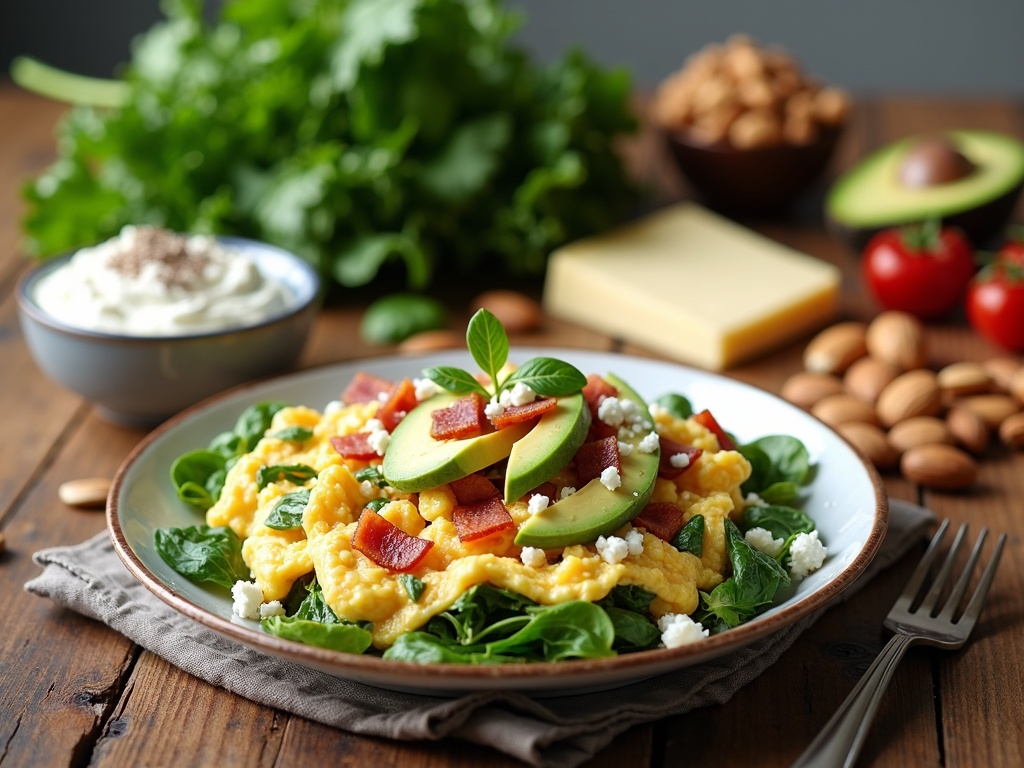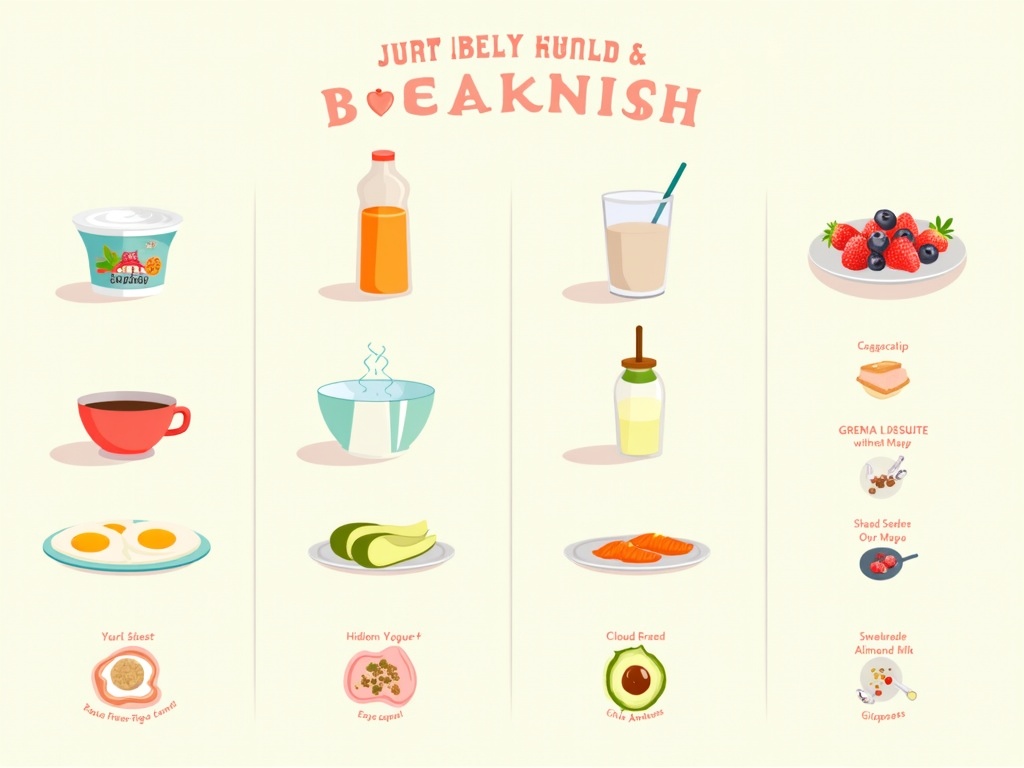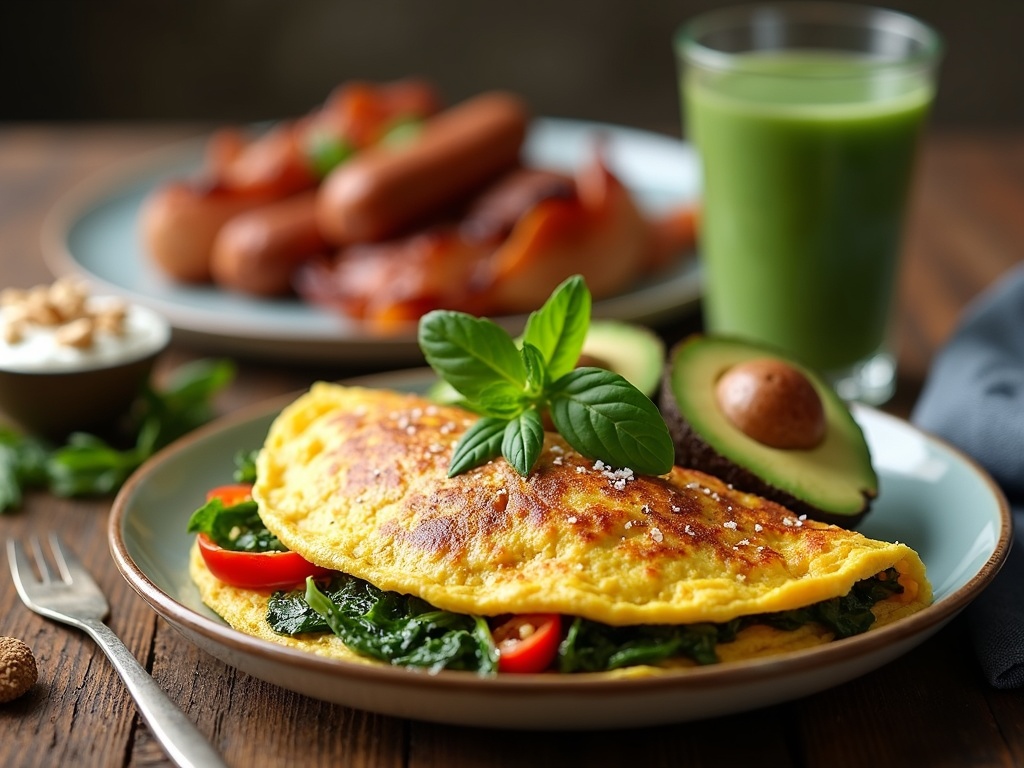No carb breakfasts have become popular for their impressive weight loss results—typically 8-10 pounds in the first few months—and for providing sustained energy, better blood sugar control, and improved mental clarity throughout the morning. The low-carb movement has gained significant traction with about 30% of American adults now following carb-restricted eating plans, especially at breakfast, where many look for options with fewer than 5 grams of carbohydrates per serving.
Find In This Article
Key Takeaways
- No-carb breakfasts help maintain stable blood sugar levels, preventing energy crashes and reducing cravings for sugary foods later in the day.
- Protein-rich options like eggs, Greek yogurt, and quality meats form the foundation of satisfying zero-carb morning meals.
- Healthy fats from sources like avocados, nuts, and cheese add flavor while helping maintain fullness until lunch.
- Common pitfalls include hidden sugars in condiments, flavored yogurts, and breakfast drinks that can sabotage low-carb efforts.
- Meal preparation strategies, such as making egg muffins or keeping hard-boiled eggs readily available, help maintain the no-carb breakfast routine even on busy mornings.
Why No Carb Breakfasts Are Trending
The low-carb movement has gained serious momentum, with about 30% of American adults now following some form of carb-restricted eating plan. I’ve noticed this trend growing particularly strong in the breakfast category, where people are seeking options that contain fewer than 5 grams of carbohydrates per serving.
No carb breakfasts have earned their popularity for good reason. Studies show that people who adopt this approach typically lose between 8-10 pounds during the first few months. This impressive result explains why so many health-conscious individuals are making the switch from traditional carb-heavy morning meals to protein and fat-focused alternatives.
Benefits Beyond Weight Loss
I’ve found that no-carb breakfasts offer benefits that extend far beyond just dropping pounds. These meals provide:
- Sustained energy levels throughout the morning without the mid-morning crash
- Better blood sugar control, preventing energy dips and hunger spikes
- Reduced cravings for sugary foods later in the day
- Improved mental clarity and focus during morning hours
- Easier adherence to overall high-protein breakfast for weight loss plans
The effectiveness of no-carb breakfasts for weight management comes from their ability to keep you feeling full longer. When you start your day with eggs, avocado, or cloud bread instead of cereal or toast, your body maintains more stable blood sugar levels.
No carb options can be surprisingly versatile too. From paleo breakfast recipes to gluten-free breakfast choices, the options are endless. I’ve transformed my morning routine by swapping traditional toast and oatmeal for healthy breakfast options like egg muffins with vegetables or Greek yogurt with nuts.
For those concerned about convenience, easy healthy breakfast ideas that fit the no-carb profile include make-ahead egg bites, smoothies made with unsweetened almond milk and protein powder, or simply having dinner leftovers for breakfast.
The trend shows no signs of slowing down, as more people experience firsthand how changing just one meal per day can have such significant effects on their overall health and waistline. By focusing on protein, healthy fats, and non-starchy vegetables at breakfast, many find it easier to maintain their weight loss goals while enjoying improved energy throughout their day.
Essential Ingredients for a Zero Carb Morning
Starting my day with a no carb breakfast has transformed my morning energy levels. I’ve discovered that focusing on protein, healthy fats, and fiber creates satisfying meals without the carb-induced energy crashes. The right ingredients make all the difference in crafting delicious, filling healthy breakfast options that keep me fueled until lunch.
Protein-Rich Foundation
Eggs stand as the perfect cornerstone for any zero carb breakfast. These protein powerhouses offer incredible versatility – I can scramble them with vegetables, prepare them sunny-side up, or hard-boil them for grab-and-go convenience. One large egg contains about 6 grams of protein with virtually no carbs, making them ideal for maintaining muscle and staying full longer.
Unsweetened Greek yogurt delivers another excellent protein source. With roughly twice the protein and half the carbs of regular yogurt, it creates a creamy base for various breakfast combinations. I always check labels carefully to avoid added sugars or fillers.
For those mornings when I need extra sustenance, high-quality bacon or sausage adds savory flavor and protein. I opt for nitrate-free varieties when possible to avoid unnecessary additives. These meat options pair perfectly with eggs for a high protein breakfast for weight loss that keeps hunger at bay.
Healthy Fats and Fiber
Avocados have become my breakfast MVP. Their creamy texture and healthy monounsaturated fats complement nearly any dish. Half an avocado adds richness to scrambled eggs or makes a perfect vessel for egg baking. The combination of fat and fiber helps moderate blood sugar levels while providing lasting energy.
I incorporate leafy greens like spinach and kale whenever possible. These nutritional powerhouses add vital micronutrients, fiber, and barely any carbs. A handful of spinach wilted into eggs or blended into a smoothie boosts nutrition without affecting the carb count.
Various cheese varieties add flavor dimension to zero carb breakfasts. Cheddar melts beautifully into scrambles, while feta crumbles provide a tangy contrast to savory dishes. Cream cheese can transform a simple cloud bread into a satisfying breakfast sandwich. Cheese adds calcium and protein while keeping carbs minimal.
Nuts and seeds round out my essential ingredient list. Almonds, walnuts, flaxseeds, and chia seeds add crunch, fiber, and healthy fats. A tablespoon of chia seeds contains 5 grams of fiber with minimal net carbs, while a quarter cup of almonds provides satisfying texture and nutrition to yogurt bowls or egg dishes.
For those transitioning from carb-heavy breakfasts, these ingredients offer satisfying alternatives. I’ve found that combining several elements—like a veggie omelet with avocado and a side of Greek yogurt—creates meals that don’t leave me missing toast or cereal.
Quality matters significantly with zero carb ingredients. I prioritize organic eggs from pasture-raised chickens when my budget allows, as they typically contain more omega-3 fatty acids and vitamins. Similarly, selecting grass-fed meats and organic produce minimizes exposure to pesticides and antibiotics while maximizing nutrition.
With these essential ingredients on hand, I can create endless variations of easy healthy breakfast options. Whether I’m in the mood for a savory egg scramble or a refreshing yogurt bowl, these zero carb building blocks help me construct breakfasts that support my energy levels and health goals without sacrificing flavor. For those with specific dietary needs, many of these ingredients work perfectly for paleo breakfast or gluten-free breakfast plans as well.

Creating Your Perfect No Carb Breakfast
Starting the day with a satisfying no carb breakfast sets you up for steady energy levels and helps avoid mid-morning crashes. I’ve found that mastering a few simple techniques can transform basic ingredients into a delicious meal that keeps hunger at bay for hours.
The Perfect Protein Base
Eggs are the cornerstone of an excellent high protein breakfast for weight loss. I start by heating a tablespoon of butter or olive oil in a pan over medium heat. For scrambled eggs, I whisk them in a bowl before adding to the pan, stirring gently for about 2-3 minutes until just set but still creamy. For fried eggs, I cook them for 2-3 minutes, then flip for sunny-side up or cover the pan for over-easy eggs.
Bacon or sausage adds both flavor and staying power to your morning meal. Cook bacon strips for 3-4 minutes per side until they reach your preferred crispiness. For sausage patties, 4-5 minutes per side ensures they’re cooked through while developing a nice brown crust.
After removing the eggs, I use the same pan to sauté greens like spinach or kale. The residual fat adds flavor, and they only need 1-2 minutes to wilt perfectly. Sliced avocado makes a creamy addition – simply slice half an avocado and fan it out on your plate, or mix cubed avocado into scrambled eggs in the last 30 seconds of cooking.
Greek yogurt topped with a handful of nuts and seeds creates another excellent paleo breakfast option. The combination provides protein, healthy fats, and a satisfying crunch without any carbs.
Flavoring Your No Carb Creation
The right seasonings transform simple ingredients into something special:
- Fresh herbs like chives, dill, or cilantro brighten egg dishes
- Smoked paprika adds depth to avocado and eggs
- Red pepper flakes create a pleasant heat that complements greens
- Everything bagel seasoning provides flavor complexity without the carbs
- Fresh lemon juice cuts through richness and enhances flavors
I’ve discovered that gluten-free breakfast options often overlap with no carb meals. For texture variety without bread, try cloud bread 2.0 as an occasional addition.
Temperature control makes all the difference – I keep my pan at medium heat for eggs and medium-high for meats. This ensures perfect cooking while developing flavor through slight caramelization.
By mixing and matching these elements, I can create different easy healthy breakfast combinations throughout the week. The key is balancing protein and fats while incorporating different textures and flavors to keep your healthy breakfast options interesting and satisfying.
Common Pitfalls to Avoid
Even with the best intentions, I’ve seen many people unknowingly sabotage their healthy breakfast options by making simple mistakes. Cutting carbs requires vigilance, especially when hidden sugars lurk in seemingly innocent ingredients.
Sweetened Products and Hidden Carbs
Those flavored yogurts marketed as “healthy” often contain 15-20g of sugar per serving. I recommend swapping them for plain, full-fat Greek yogurt and adding your own flavor with cinnamon or a few berries. Similarly, many breakfast drinks pack a carb punch – even that small glass of orange juice can contain 25g of carbs.
Sauces and dressings are notorious carb culprits. That tablespoon of ketchup on your eggs? It contains about 4g of sugar. I’ve found these alternatives work well:
- Use avocado oil mayo instead of regular mayo (often contains added sugars)
- Opt for olive oil and vinegar instead of bottled dressings
- Make your own sauces with fresh herbs, spices, and healthy oils
- Try salsa with no added sugar for egg dishes
Portion control matters too, especially with high protein breakfast for weight loss foods. Nuts are low carb but calorie-dense, and too many berries can add up carb-wise. I measure portions at least initially until I developed an eye for proper serving sizes.
When shopping, I always check labels for hidden sugars, particularly watching for:
- Words ending in “ose” (glucose, fructose, maltose)
- Syrups (corn syrup, rice syrup)
- Fruit juice concentrates
- Honey, agave, or molasses
Many companies hide sugars by using multiple types in smaller amounts, allowing them to list these ingredients further down the label. I always check total carbs rather than just the “sugars” line.
Another mistake? Assuming all paleo breakfast options are low carb. Some paleo-friendly foods like sweet potatoes or certain fruits are relatively high in carbs.
I’ve found success by sticking to easy healthy breakfast options like eggs with avocado, cloud bread topped with smoked salmon, or chia pudding made with unsweetened almond milk. These satisfying alternatives help me stay on track without feeling deprived.
When dining out, I ask for gluten-free breakfast options but still verify they’re truly low-carb. Many restaurants have gluten-free items that still contain high carb ingredients like potato, tapioca flour, or rice.
By learning to identify these common pitfalls, I’ve made my no carb breakfast routine sustainable and effective for my health goals.

Creative No Carb Variations
I’ve discovered that no carb breakfasts don’t have to be boring or repetitive. With a bit of creativity, you can enjoy delicious morning meals that keep you satisfied without the carb crash. These variations will help you start your day with energy while sticking to your low carb goals.
Protein-Packed Egg Creations
Egg muffins have become my go-to for busy mornings. I simply whisk eggs with a pinch of salt and pepper, fold in chopped bell peppers, spinach, and a sprinkle of cheese, then bake in a muffin tin at 350°F for about 20 minutes. The best part? I can make a batch on Sunday that lasts the entire week. For extra flavor, I sometimes add herbs like basil or dill.
Shakshuka offers another egg-based option that feels indulgent without the carbs. I start by simmering a sugar-free tomato sauce with onions, garlic, and bell peppers, then crack eggs directly into the sauce. The runny yolks mix with the tangy sauce creating a rich breakfast that pairs perfectly with cloud bread if you want something to soak up the sauce.
For those mornings when I need something substantial, I arrange a gourmet cheese and meat platter. This isn’t just ordinary deli slices – I pair aged cheeses with prosciutto, olives, and fresh cucumber slices. The combination of protein and healthy fats keeps me full for hours, and there’s something satisfying about the variety of flavors and textures.
Innovative No Carb Alternatives
No carb smoothie bowls have transformed my breakfast routine. Unlike traditional smoothies loaded with fruit sugars, I blend unsweetened almond milk with spinach, half an avocado, a scoop of high-protein supplements, and a touch of stevia. The result is a creamy, nutrient-dense base that I top with unsweetened coconut flakes, chia seeds, and a few berries for minimal carb impact.
Seasonal ingredients can elevate any no carb breakfast. Here are some options I rotate throughout the year:
- Spring: Asparagus and herb frittatas with goat cheese
- Summer: Chilled cucumber soup with dill and Greek yogurt
- Fall: Roasted pumpkin puree (unsweetened) with cinnamon and collagen peptides
- Winter: Warm bone broth with poached eggs and greens
Protein customization has been key to keeping my paleo breakfast interesting. I’ll often prepare a base recipe, then add different proteins throughout the week:
- Leftover shredded chicken from dinner
- Smoked salmon for a luxurious touch
- Diced turkey or beef for heartier options
- Tofu scrambles (for plant-based days)
My make-ahead strategy has saved me countless mornings. On Sunday, I’ll prepare egg muffins, portion out smoothie ingredients into freezer bags, and marinate proteins. This approach ensures I have easy healthy breakfast options even on hectic days.
I’ve found that thinking beyond traditional breakfast foods opens up a world of no carb possibilities. Leftover protein from dinner makes an excellent breakfast, especially when paired with avocado or a side of olives. Many gluten-free breakfast recipes can be modified to be completely carb free with simple swaps.
By focusing on quality proteins, healthy fats, and non-starchy vegetables, I’ve created a rotation of healthy breakfast options that keep me satisfied until lunch without the mid-morning energy crash that often comes with carb heavy breakfasts.
Health Benefits and Considerations
Starting my day with a high protein breakfast for weight loss has completely changed my morning energy levels. When I eliminated carbs from my breakfast, I noticed significant improvements in how I felt throughout the day.
Nutritional Advantages
The high protein content in no carb breakfasts supports muscle maintenance, which is especially important if I’m trying to preserve lean mass while losing weight. My body uses this protein to repair tissues and build strength, even when I’m not actively working out.
Healthy fats are another key component that provide sustained energy throughout the morning. Unlike the quick spike and crash from carb-heavy meals, the energy from fats burns slowly and steadily. This makes healthy breakfast options that focus on fats and proteins ideal for maintaining consistent energy levels.
Foods high in protein and fats maintain satiety much longer than carbohydrates. When I eat eggs, avocados, or cloud bread instead of toast or cereal, I don’t get hungry again until lunchtime. This reduced snacking has helped me maintain better control over my daily caloric intake.
Important Considerations
Before starting any significant dietary change like a no carb breakfast regimen, consulting a healthcare provider is essential. This is particularly important for people with existing health conditions like diabetes or kidney issues.
The long-term sustainability of a completely carb-free breakfast deserves careful thought. While some people thrive on paleo breakfast options, others might find it restrictive over time. I’ve found that cycling between very low carb and moderately low carb breakfasts works best for my lifestyle.
Meal prep has been my secret weapon for sticking with easy healthy breakfast choices. Here are some strategies that have worked for me:
- Preparing egg muffins or frittatas on Sunday for the entire week
- Making overnight chia seed pudding with unsweetened almond milk
- Cooking extra protein at dinner to repurpose for breakfast
- Keeping hard-boiled eggs, avocados, and nuts readily available
- Creating freezer-friendly gluten-free breakfast options like protein pancakes
By taking time to prepare these options in advance, I’ve found it much easier to stick with my no carb breakfast plan, even on the busiest mornings when I’d otherwise be tempted to grab something quick and carb-heavy.
Sources:
Journal of the American Heart Association – Low-Carbohydrate Diets and Overall Mortality
Annals of Internal Medicine – Effects of a Low-Carbohydrate Diet on Obesity and Cardiovascular Disease
Health Affairs Journal – Weight Loss Diets: A Public Health Perspective
Harvard Health Publishing – Understanding Low-Carb Diets

